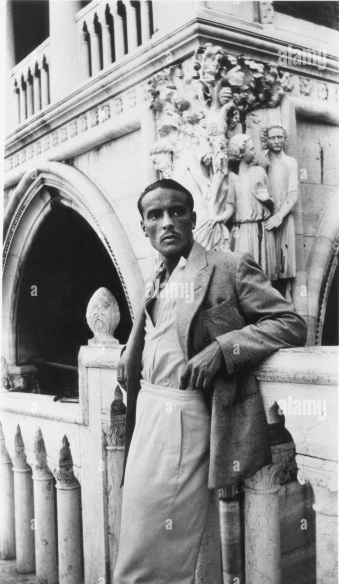If, as the trite phrase goes, a picture is worth a thousand words, what can a filmed dance tell us? In her journal on the making of the 1984 Dance in America documentary “Balanchine,” Holly Brubach, its writer, noted that the following three-minute piece of film to be included was “The biggest find of all”:
This find (clip courtesy of the YouTube channel Celluloid Tapestry) is a short ballet appearing in a 1929 British ‘talkie’ film titled Dark Red Roses. And the handsome, high-cheekboned face of the dancer seen in the close-ups is none other than that of—George Balanchine.
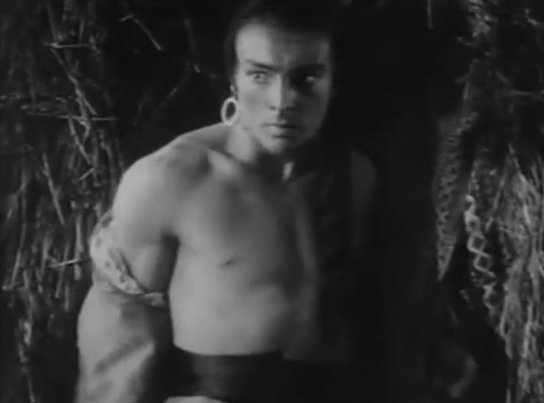
All of 25 years old, Balanchine was already an established choreographer, having by then created ten ballets for the Diaghilev Ballets Russes. He also choreographed this little cinematic number, described as a “Tartar Ballet,” for himself and two colleagues, fellow Ballets Russes alumni Anton Dolin and Lydia Lopokova. Seen with no introduction (and without its contextual movie), we can still grasp the dance’s action, of Dolin and Lopokova as a pair of rapturous lovers and Balanchine as a vengeful cuckolded spouse. The dance is nothing like the Balanchine choreography we’re used to, and if I hadn’t read his credit for it on both the IMDB and BFI websites, as well as in the Bernard Taper and Richard Buckle biographies, I’d never have guessed it to be a Balanchine ballet. I don’t know if anyone else, also coming to it cold, would either.
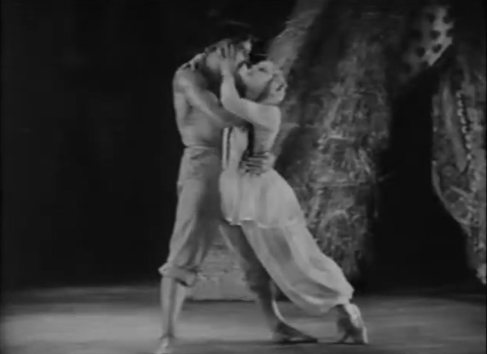
Despite its, shall we say, non-Balanchinean look, the piece does have importance as a filmed record, however brief, of a young Balanchine in performance (along with Lopokova and Dolin). And Balanchine doesn’t just dance. He emotes, his dark eyes (in those close-ups) flashing Valentino-style at a clinching Dolin and Lopokova, and then, after a dance battle with Dolin, fiercely slicing the latter’s wrists. It’s a rare glimpse of Balanchine in dance motion; note how he uses body and gesture to emphasize the drama, such as the muscular thrust of back and shoulders when he grabs Dolin’s arms and, with an emphatic swipe, slashes his hands.
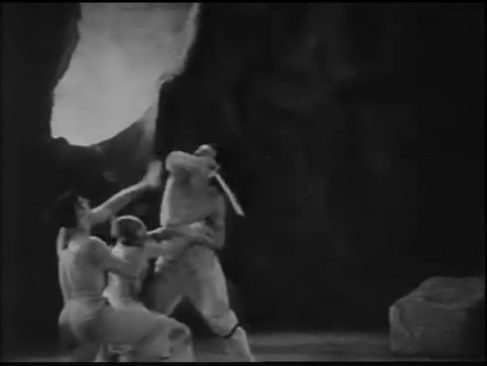
Reaction to this dance has not been too positive. The writer of this Artsmeme article compares the DRR piece to Balanchine’s Apollo, created one year earlier, unfavorably contrasting the later piece’s “crude” choreography to the earlier’s clear, serene classicism. The writer assumes the DRR number was put together hastily (“fifteen minutes”) before filming, and perhaps that was so; per Taper, the dancers had to wait at the studio for hours, before filming at the unholy hour of 2:30 a.m. By today’s cinematic standards the film’s technique is certainly crude, its stationary camera awkwardly cutting between mid- and long shots, especially at the climax, dwarfing its dancers by distance. And I wonder if Dolin choreographed his own short solo to suit his high-jumping, turned-in technique. Balanchine would probably have let him.
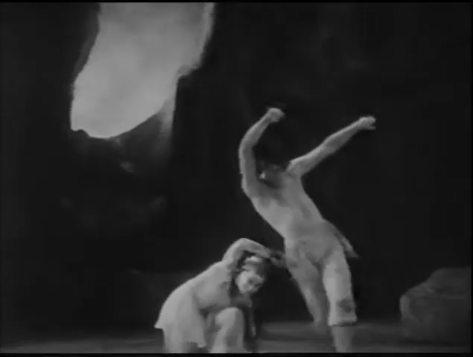
The Artsmeme writer also speculates if the “lower value” assigned to filmed versus live performance is what accounts for the difference between this rough-looking effort and Balanchine’s 1928 masterpiece. I’m not disputing the difference between Apollo and the Tartar number, but I’m curious as to what is meant by “lower value.” Is that the value placed by Balanchine or by the DRR filmmakers? Balanchine created this ballet for hire, for a specific purpose in the film. Per BFI, DRR’s plot centers on a jealous triangle between a husband, his wife, and another man (the three audience members seen in edited inserts). Hence the ballet in the film reflects the narrative’s overarching marital jealousy theme. As Taper notes, like “The Mousetrap” in Hamlet, it enacts a drama also taking place in the film’s ‘real’ story.
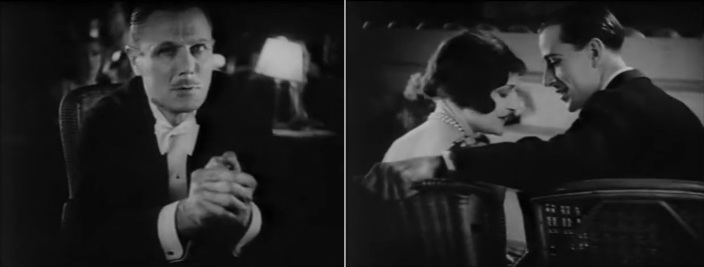
True, Balanchine is not working here in an Apollonian vein, but such crystalline classicism is not called for. Think more the dark, bloody seam of an Othello or Medea—of raw, primitive jealousy bursting, from tenuously held civilized restrictions, like an infected wound. The music is from the opera Khovanschina, by Modest Mussorgsky, a composer noted for works steeped in Russian national identity and culture. That accounts for the dance’s setting, in what looks like a medieval Asian encampment, with rough-hewn choreography to match. What’s being tapped here is a melodramatic, even crude depiction of primal passions, sans the mitigations of refined classical technique.
Thus the ballet serves another story function, as an emotional subtext mirroring the husband’s cuckolded fury. And that is what Balanchine’s composition does, compressing into the dance’s few filmed minutes a roiling mini-drama of illicit love and murderous rage. If its choreography is unremarkable, its arrangement does reify, in music and motion, the husband’s turmoil, as well suggesting a brutal method of revenge (cutting off the lover’s hands). Though hokey to our eyes, its drama is clear, its action sharp and swift, its ending even a bit of a shock. It’s obviously not comparable to Balanchine’s later neoclassical masterworks, and it reeks of clichéd melodrama (note his entrance, creeping unobserved behind the lovers, like a 19th-century stage villain), but you can grasp that the guy who made this piece could tell a story and get right to its meat—like plunging a dagger straight into the heart.
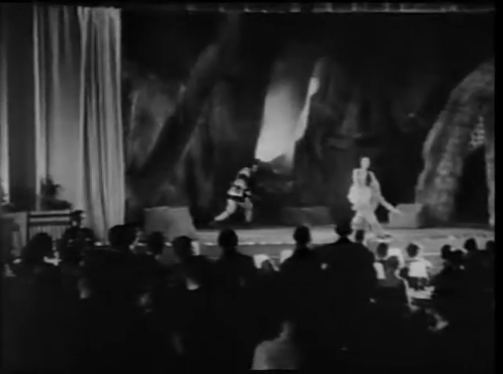
Per Judith Mackrell’s biography, Bloomsbury Ballerina, the ballet’s composition was first entrusted, not to Balanchine, but to Lydia Lopokova. Now living in Britain and married to John Maynard Keynes, Lopokova was asked in June 1929 by the theater and film producer Oswald Stoll “to produce a short ballet with an ‘oriental’ style and an adulterous theme.” Interested (and with a persuasive thousand-pound fee), Lopokova “cooked up” an overheated scenario of a woodcutter, his wife, and an amorous minstrel that comes to a boil on the Central Asian Steppes. Casting Dolin and Balanchine in the male leads, she entrusted the choreography to the latter, with Balanchine working, as he often did, quickly. A Lopokova friend viewing the results was “horrified by [its] histrionic clichés,” and, Mackrell notes, “it is hard, today, to disagree with [the] verdict.” Yet, Mackrell writes, “Jealousy,” as the piece was titled, “was very much of its era in its mix of popular dance conventions and silent-screen melodrama”; per the dancer Frederic Franklin, the ballet would have been “’completely acceptable for those days.’” Mackrell also praises Lopokova’s performance, her “abandon with which she arches forward to kiss Dolin,” and how her “blank, destroyed expression…as she is subdued by the triumphal Balanchine, still work[s] a potent effect.”
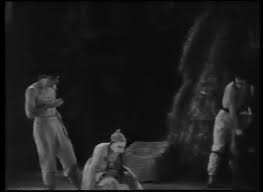
Like Balanchine, Lopokova was working for hire, on request from Stoll, who knew Lopokova from when he had presented the Ballets Russes in London after the First World War. You might assign a chain of blame here, moving up from Balanchine to Lopokova to Stoll and his producers and backers—up to Stacy Aumonier, who wrote the 1924 short story on which the film is based. Only in Aumonier’s crisp narrative, there’s no theater visit, no dance presentation, no…grisly balletic enactment of revenge. All that was added by the filmmakers, I’m guessing to pad their film to feature length, as well as to heighten its sensationalizing possibilities. It seems the producers wanted Melodrama; and Melodrama is what Lydia and George gave them.
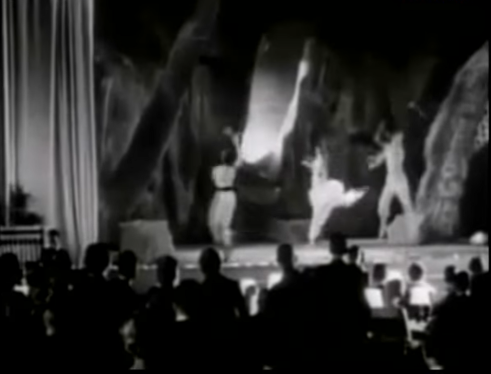
But why the ‘oriental’ style? And why, in a story of adultery among the London upper classes, the ‘primitive’ look?
My own sense, even theory, if you will, is that DRR’s chain, of inspiration in this case, may go back further—back to the Ballets Russes itself. All three DRR dance principals were associated with Diaghilev’s company, and all three achieved fame because of that association. But Lopokova goes back to almost the start—joining the company in 1910 (a year after its debut in Paris), and again during the WWI years. Along with such dancers as Nijinksy, Karsavina, Fokine, and Bolm, Lopokova will always be associated with the originators—part of that first wave, the prime movers, when everything about the company was bold, daring, and new. Everything it did had never before been seen by the upper-crust Europeans attending its performances, and everything those audiences saw was a revelation—ballets created for a new century, a new continent, a new, modern era.
As with most first impressions, and first loves, those early Ballets Russes ballets—with their then-revolutionary choreography, their exotic themes, their brilliantly colorful, almost fantastic sets and costumes, created by dancers and choreographers from the mysterious, ‘barbaric’ East—were deeply imprinted on collective audience memories. And the young (barely past 18) Lopokova—spirited, piquant, possessing a high, light jump comparable to Nijinsky’s—quickly gained audience adoration. Her tenure with the company was erratic; after her first year she left for a five-year sojourn in America before returning, and she maintained an irregular performing schedule with the company thereafter. Yet her link to the Ballets Russes’s early years is indelible; she was cast in such significant productions as Carnaval, Les Sylphides, the “Polovtsian Dances” from Prince Igor, and The Firebird (in the title role). All of which were created by the company’s first choreographer, Michel Fokine.
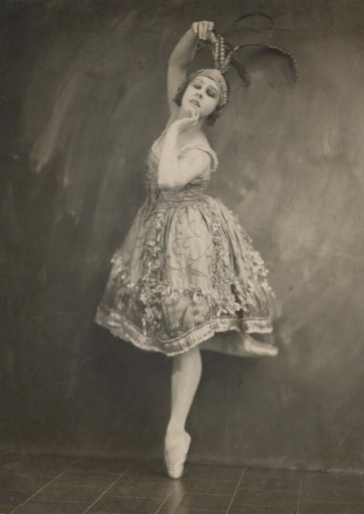
Fokine, and the chance to dance his ballets, was the main reason for Lopokova’s joining the company in 1910 (they worked together again, briefly, on a flop Broadway show in 1920). He had been her instructor at the Maryinsky, when, says Mackrell, he was creating dances that would “open up the art form to a fuller, more human range of expression,” while also incorporating “the uncorrupted vigor of Russian folk tradition.” Such “expressive choreography,” writes Alison Light, was something to which Lopokova “responded instinctively…[and to Fokine’s] rebellion against the stiff academicism of the classical style.” No doubt, Lydia was in sync with Fokine’s emotionally charged aesthetics: As Cyril Beaumont remembered her, she was a dancer of extraordinary spontaneity, “electrif[ying] the audience with the sheer joy and seemingly boundless vitality of her movements.” And Mackrell notes how Lydia “interpreted…choreography through her own idiosyncrasies and her own imperfections”—a personal, unformulaic quality that would have appealed to Fokine.
My point is simple: Stoll’s demand for an ‘oriental’ ballet resulted in a work that was a throwback to the pre-WWI Ballets Russes, then dominated by Fokine’s ‘oriental’ ballets. These included not only the above-mentioned works, but also his folk-accented Petrushka (in which Lydia danced the Ballerina Doll), the ‘Eastern’-themed Cléopatrê (in which she danced the Bacchanale), and the barbarously splendid Schéhérazade (still wowing audiences of the various Ballets-Russes-manqué companies throughout their 1930s-40s barnstorming tours in Europe, Australia, and North and South America). It was a vein cannily mined by Diaghilev during the company’s early tours, he understanding, according to Peter Lieven, that “[t]he West expected…not only Russian national colour but something like Eastern Asiatic exoticism” from anything labelled ‘Russian.’ Like Balanchine creating his Tartar piece, Diaghilev was giving the public what it wanted.
If any particular Fokine work might have influenced “Jealousy,” I would point to his “Polovtsian Dances,” which had thrilled those 1909 Parisian audiences with its “savage, warrior energy” set on the Russian steppes, with, per Mackrell, Lydia’s “baby face…creat[ing] a poignant contrast to the muscular primitivism” of its dance. Could its “oriental” as well as expressively “savage” style have been in Lydia and George’s minds when putting together “Jealousy”? Echoes of such “muscular primitivism” can be seen in Balanchine’s ‘ethnic’ steps, in the male dancers’ whirling jumps and thrusting arms and backs, and in the work’s uninhibited zest. (Of further note is Prince Igor’s composer, Borodin, who, like Mussorgsky, was one of ‘The Five,’ a group of Russian composers creating a unique national musical style.) Perhaps not so coincidentally, Lopokova’s last performance with the Ballet Russes, in 1927, was as the lead Polovtsian Maiden, in which, says Mackrell, “with a proud determination to prove herself, kindled…a performance that matched all her former ‘barbaric abandon’ in the role.”
(Courtesy of the inwit YouTube Channel)
By the 1920s, of course, the Ballets Russes had changed. Its look, its style, its choreographic emphasis, had been transformed to one more “austere,” modern, and experimental, as reflected in the works of Balanchine, Bronislava Nijinska, and Leonide Massine. Lopokova would herself become a Massine muse, he creating probably her two best roles in Les Femmes de Bonne Humeur and La Boutique Fantasque. Yet in 1920s London, right before Dark Red Roses was filmed, ballet was still ‘The Ballets Russes’; as Buckle notes, “’ballet’ had meant the Diaghilev Ballet.” And Diaghilev was still presenting to new audiences those old favorites on which the company had established itself, not only as the vanguard of bold new art, but as ‘Russes’—the dances evoking what Mackrell calls that country’s “refined melancholy and its barbaric soul.” As late as 1948 that notion of ‘Russes’ was still influencing such movies as The Red Shoes, in which the exotic, ‘primitive’ “Heart of Fire” ballet is danced by the film’s clearly Diaghilev-inspired company.
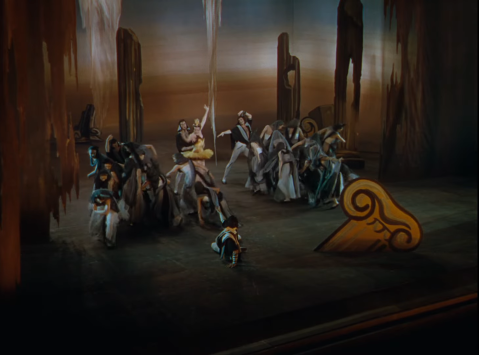
In requesting Lopokova to create an ‘oriental’ ballet for his adultery-themed film, Stoll was asking not for a work austere and modern, but in the style of what Europeans would have associated with the pre-War Ballets Russes—something audacious, wild, even ‘savage.’ As noted, the result today does look corny; could Balanchine’s overt melodramatics and huffing-puffing emotionalism have also been, in part, a sendup of Fokine? Like “Jealousy,” I suspect much of Fokine’s once-celebrated oeuvre, le dernier cri of its time, will look old hat today, as dated as Dark Red Roses‘ silent-film posturing. As the Artsmeme piece points out, Balanchine was already mining a different, ‘pure-dance’ aesthetic, even as he created, and danced, “Jealousy”‘s enraged cuckold. That may account for the enduring popularity of Fokine’s lovely, pure-dance Les Sylphides—perhaps because Balanchine has educated us over so many decades to respond to such. But by the 1920s Fokine had long left the Ballets Russes, “which,” says Beaumont, “he honestly considered to be his own creation.” Finding a new home in New York, he would set up his own ballet school and company—a route later followed by Balanchine himself.
If ”Jealousy” could be a symbolic last gasp of the pre-WWI Ballets Russes style, it also, in a sadly ironic twist, marked the actual end of the company. On August 19, 1929, while Balanchine, Lopokova, and Dolin waited in a chilly Islington studio to begin filming their little Tartar ballet, Dolin stepped out for a newspaper, only to rush back with the news that Diaghilev had died earlier that day in Venice. The three dancers, “sad figures,” says Taper, “dressed up in the costumes of their exotic mummery, sat on in the gloom and damp chill of the studio” until finally summoned to perform. “How we danced,” Dolin later recalled, “I do not know.” With Diaghilev’s death, all that had been the Ballets Russes—its dancers, designers, choreographers, its groundbreaking ballets—had ended, as sudden a finish as “Jealousy”‘s finale, leaving company members bereft and scattered. “It wasn’t just the end of the Ballets Russes,” writes Tina Sutton, “but the end of an era.”
Other ‘Ballet Russe’ companies would soon follow (Colonel de Basil’s and Sergei Denham’s), presenting new works as well as the old, beloved Diaghilev classics, and in which groups both Balanchine and Dolin would participate, before founding companies of their own. But the first Ballets Russes—the ‘original’ original, exploding with youthful vigor and confidence before the jaded eyes of Europeans, whose previous idea of ballet had been pretty girls in tutus and tights—that would never be repeated. Today over 100 years later, remnants of that time remain, in surviving repertory, in histories, memoirs, memorabilia, documentaries, and, especially, in pictures—of its young and beautiful dancers, in exotic costumes and exotic poses, ghostly images from a dance world long gone.
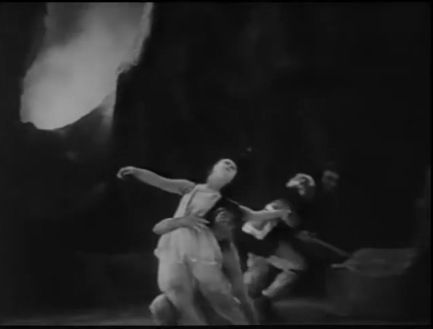
What does live on, however, is the company’s driving aesthetic, of dance as a serious art form, the expression of talented, dedicated artists—today associated with the career of one of Diaghilev’s last choreographers, George Balanchine. Who, coincidentally or not, was filmed almost literally at the moment of Diaghilev’s passing. Surely this early moving image of him can still tell us much about this artist—young, robust, movie-star handsome, already a recognized talent but with his greatest works ahead. And preserved right when everything for him, his art, his audiences, was bold, daring, and new.
